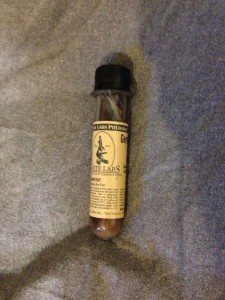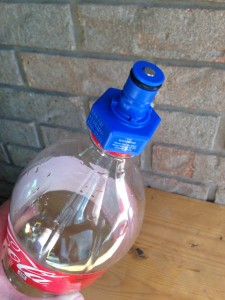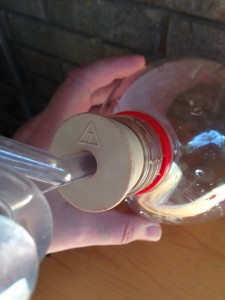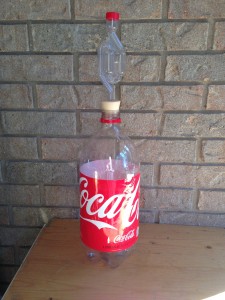If you drink soda — pop, Coke, or whatever you call fizzy sugar water in your neck of the woods — you know what PET bottles are. These plastic bottles are used in the soda industry because they are lightweight and retain carbon dioxide (CO2) in carbonated beverages. Many homebrewers wonder if these would make suitable beer containers. There certainly would be a variety of benefits to using them.
Positive Attributes
Environmentally-conscious homebrewers may like that they could reuse a bottle rather than throwing it away (if they live somewhere without recycling). If they drink soda, cost-conscious homebrewers might see a source of essentially free bottles. Homebrewers who like hiking and camping would have a lightweight container that could easily be packed in and packed out of a campsite. In fact, most homebrewers can probably think of a time when having beer in a lightweight, disposable package would be a benefit. For example, if you’re going to a party and don’t want to bring a full keg, or lug a case of beer in glass bottles, you could bring a couple 2-L or 3-L bottles. And when you leave, you could just leave the bottles behind. You might not want to do that with “nice” bottles of homebrew (heavy, dark bottles with the labels removed).
In addition, PET bottles are essentially unbreakable; if you drop one, you won’t be cleaning shards of broken glass off the floor. So, if they are such a great container, why don’t commercial breweries use them?
PET and Oxygen Permeability

White Labs tubes are made from PET. In fact, they are the “blanks” that are used to make 2-L bottles.
PET bottles (sometimes called PETE bottles, and bearing the #1 recycling code) are made from polyethylene terephthalate. There are lots of different variants of PET bottles. For this article, I’ll limit the discussion solely to the “regular,” thin-walled soda bottles. As I mentioned, one reason to use PET bottles for soda is the ability of PET containers to retain carbon dioxide (CO2). However, the permeability of PET with regards to oxygen is a concern of brewers. Keeping CO2 in is a necessary feature of a beer bottle, but keeping oxygen (O2) out is also important. If oxygen can enter the bottle, the beer will go stale faster. And this is why you don’t see commercial beer packaged in “ordinary,” thin-walled PET bottles — they are permeable to oxygen. (There are thicker bottles and specialty bottles that use a layer of polyvinyl alcohol between layers of PET to lower oxygen permeability.) In addition, many PET bottles are clear and most brewers would prefer a dark bottle to prevent the beer from becoming lightstruck.
On the Other Hand . . .
Commercial breweries don’t sell beer in regular PET bottles because the shelf life of their product would be lowered. Likewise, if you are a homebrewer who is bottling a beer you intend to age, I would not recommend putting it in PET bottles. However, there are some times when bottling in PET would be acceptable.
Oxygen permeability isn’t an all-or-nothing kind of thing. The rate of oxygen ingress is important. As mentioned before, PET bottles retain CO2 very well. Oxygen gas (O2) is a slightly smaller molecule and some can cross through the plastic. The rate at which this occurs is sufficiently high to rule out long-term storage of beer (as long as commercial beer might reasonably sit on a store’s shelf). However, over shorter terms, the rate is small enough that it shouldn’t cause a problem.
Certainly, beer can be stored in PET bottles for very short amounts of time, hours or a few days. If you fill a few bottles from a keg to bring to a party, homebrew club meeting or weekend camping trip, your beer will be fine. The amount of oxygen exposure from transferring the beer to the bottle would greatly exceed the amount of oxygen that reached the beer by passing through the walls of the bottle.

A Carbonator Cap fits a standard soda bottle (here a 2-L Coke bottle) and accepts a gas in fitting (ball lock) from a Corny keg.
In my homebrew club, lots of brewers bring their beer to the meetings by filling a PET bottle from the keg, then attaching a Carbonator Cap. This is a cap that screws onto a 2-L soda bottle and connects to a standard Corny keg gas in fitting (ball lock). Storing the bottle for a short time under regular keg CO2 serving pressure ensures that any carbonation lost when filling the bottle is replaced. (The manufacturer recommends not exceeding 40 PSI when using the cap on plastic bottles.)
Beer can even sit for a few weeks in a PET bottle — long enough to bottle condition before being served — and still not taste recognizably different from homebrew bottled in glass or kegged.
The maximum length of time that beer would stay good in a PET bottles depends on a few things — temperature, how careful the brewer was to exclude oxygen when transferring the beer to the bottles, and how sensitive the beer drinker is to oxidized notes in their beer. In graduate school, I bottled a fair amount of beer in 2-L PET bottles out of necessity. Also, I had far more beer than I had fridge space. Based on my experiences, I would tentatively say that you can store beer in PET bottles at room temperature for 2 months and still have it taste reasonably fresh. (Fresh enough that someone who knows what oxidized beer tastes like isn’t going to be offended.) Keep the beer in a box or closet to shield it from light. Stored cold, it should stay fresh longer, but not the 6 to 8 months that ordinary homebrew (in glass bottles) remains fresh.
So, if you think your beer might sit around for awhile, either keg it or put it in glass bottles. However, if you know of an event in the next couple months for which having beer in a lightweight, disposable (or recyclable) bottle would be a benefit, don’t be afraid to bottle however much you think you’ll use in PET bottles.
The Best Use for PET Bottles in Homebrewing
I have found one very good use of PET bottles in homebrewing — as a yeast starter container. The 3-L soda bottles have a wider mouth than the 2-L bottles. A #6.5 or #7 stopper — the same size used in most carboys — fit’s the 3-L bottle’s opening. In a 3-L vessel, you can ferment about 2.5 L of starter wort. This is enough volume to raise sufficient yeast for 5.0 gallons (19 L) of ale up to OG 1.070. Soda bottles are sanitary until opened, so a light cleaning followed by a quick soak in sanitizing solution is all you need to prepare the bottle. Be sure to cool your starter wort before transferring it to a PET bottle.




The only thing I have ever used 2L bottles for are for making a quasi-ice boch. You can pour in a 12oz bottle of beer, cap it, lay it on its side in the freezer, wait for it to freeze, then flip it upside down over a glass uncapped. As it thaws, the alcohol and other non-water goodies will thaw and drain out much faster than the water, and voila, you have a more concentrated brew.
You can also carbonate directly in these bottles. For best results, the beer (or any liquid, juice, etc) should be cold and be completely free of particulates. Fill it about halfway up, squeeze all the air out by collapsing the bottle, fill with CO2, and shake a bit. Repeat this a couple of times and you’ll have a carbonated beer ready to drink in a few minutes. I’ve seen this method used before for carbonated cocktales, but never for beer.
– Dennis, Life Fermented Blog
When I was in the Czech Republic, I noticed that they sold beer in 2 liter PET bottles. It was less than a dollar a bottle. I’m guessing this beer did not stay on the shelves, and was consumed quickly. It was VERY good.
I use PET 2 L bottles with the carbonating caps when I keg a beer that was brewed for the first time. I want a quick answer to whether to brew it again. When I go to pool parties, bbq’s etc. I take a couple of 2 L pop bottles with me. No worries about glass around a pool and such. I can’t seem to find any brown 2 L pop bottles around where I live though.
Try Green Mountain Dew Bottles. Better than clear.
I’ve used PET bottles for over 20 years with no issues, but my beer hasn’t hung around long enough to oxidise. I used them after seeing 1 litre bottles for attenuation tests in breweries go spherical without bursting. Another advantage is that you can literally feel how carbonated your beer is too. I might consider glass bottles now though, especially if I make something to be kept.
Plastic is also good for going to the track. Glass isn’t allowed. Many counties in NC have a race track and it’s a bit more fun with your own homebrew.
I like your take on using the bottles for a starter, since those don’t hang around long anyway.
I wonder if this could also be a reason Mr Beer kits get a bad rap. They come with PET bottles, and if someone didn’t drink them quickly enough, then shared them, they could be unpleasant.
I was re-reading the BYO U article this morning and Terry Foster’s article was about cellaring beer. In that, he pointed out that any flaw in a beer will be accentuated by aging. If PET bottles accelerate the aging process, then flaws will become evident more quickly. (Which I think was an ancillary point of this article.)
This was a really good article, as I was starting to look at the PET bottles around here as a source for cheap, large-volume containers to speed up the bottling process.
Rather undeservedly…PET bottles are taking it on the chin here.
The main problem re-using soda bottles is not the botttle…it’s the cap b/c they are not re-usable.
You need to use re-usable caps like the ones sold with the MrB botting system.
These caps last for years.
Thanks for pointing that out, Herb. I’m not surprised by that, since you can’t really count on having carbonation in your 2L bottle once you open it. It’s almost impossible to get those caps tight enough to preserve carbonation.
I’ve bottled everything in 1-L or 500-ml PETs since 2006.
They’re a great re-usable package well suited for regular brewing (2x / mo); however, PETs are not more-better for long-term aging (> 1 yr).
As for the durability of after-market caps, mine began to fail after six years of service.
$0.15 each…cheap at half the price!
-HM
Any explanation for this? Just degradation of the PET material?
http://youtu.be/hz5czFVaeP0?t=6m
Thanks for the awesome article!
The guy didn’t show an actual bottle, so it’s hard to know. My guess is that the bottle was lined with an oxygen barrier. Some bottles — but not the soda bottles discussed in the article — have a layer of polyvinyl alcohol (or other oxygen barrier) between layers of PET. Maybe the layers started coming apart. Hard to know. It would be interesting to know how the bottles were treated; for example, how were they cleaned and sanitized. By which cleaners and sanitizers were used and what was the contact time? Were they sanitized with heat?
Thanks Chris Colby very interesting indeed, Its a big help.
Cheers Dan ABA for Finding this article and pointing it out.
Hey I got a great video here on bottling beer:
https://www.youtube.com/watch?v=MYN2OpIr37c
Hello, after reading this awesome article i am too happy to share my know-how here
with colleagues.
I’ve made a light, dry sparkling ginger mead (often but not always with grapefruit zest) for decades that uses ale yeast and just 5 lbs of honey to 6 gallons of water (so roughly 4.5 ABV). I prime and carbonate/bottle it in 2 liter diet coke bottles with an actual yield of 10-11 bottles. I used to use diet Squirt/Fresca bottles, fearing coke flavor may be retained, but that has proven to be a non-issue.
The combination of low gravity and ale yeast allows me to bottle after two weeks and enjoy after two more weeks. It does improve slightly up to two months, but I’ve never kept it around longer than that. It makes a great zero carb, lowish alcohol summer quencher and costs just over $1.00 per two liter bottle.
Bentonite added with the yeast reduces the lees and makes them more compact (as well as clarifying).
The beauty of diet soda bottles is that the contents are naturally hostile to bacteria/mold. I cap the bottle when the soda is gone, then just a quick rinse (no sanitizing) on bottling day and they are ready to be filled.
Safale S-33 has been my goto, but I’ve lately been experimenting with S-04 and SafCider yeast. S-33 works well but leaves a not-unpleasant ale yeast funk (fades after a few weeks) so I’m trying for a cleaner finish – not sure whether I’ll actually enjoy it more.
I usually reuse the yeast cake once, but have found it may fail to carbonate if I try a third round.
I don’t reuse the bottles.
Don’t fear your pets!
I’ve been using PET bottles for years. I used to brew in them with pressure caps. Now I brew in a gallon gas container and then bottle directly into PET bottles. I add oz/gal sugar to the fermenter after it stops the first time, then wait an hour or so before bottling. Still experimenting. I measure the wt of the fermentation to determine concentration. It works great.
I have found that the plastics bottle caps don’t always seal perfectly and couldn’t get the half liter bottles to pressurize. So I lay them on their side till they are firm, then put them upright so the sediment is at the bottom. Seem to work.
I worry a little about them exploding, but it’s never happened. Can beer yeast even reach PET bottle bursting pressures?